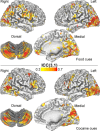Overlapping patterns of brain activation to food and cocaine cues in cocaine abusers: association to striatal D2/D3 receptors
- PMID: 25142207
- PMCID: PMC4306601
- DOI: 10.1002/hbm.22617
Overlapping patterns of brain activation to food and cocaine cues in cocaine abusers: association to striatal D2/D3 receptors
Abstract
Cocaine, through its activation of dopamine (DA) signaling, usurps pathways that process natural rewards. However, the extent to which there is overlap between the networks that process natural and drug rewards and whether DA signaling associated with cocaine abuse influences these networks have not been investigated in humans. We measured brain activation responses to food and cocaine cues with fMRI, and D2/D3 receptors in the striatum with [11C]raclopride and Positron emission tomography in 20 active cocaine abusers. Compared to neutral cues, food and cocaine cues increasingly engaged cerebellum, orbitofrontal, inferior frontal, and premotor cortices and insula and disengaged cuneus and default mode network (DMN). These fMRI signals were proportional to striatal D2/D3 receptors. Surprisingly cocaine and food cues also deactivated ventral striatum and hypothalamus. Compared to food cues, cocaine cues produced lower activation in insula and postcentral gyrus, and less deactivation in hypothalamus and DMN regions. Activation in cortical regions and cerebellum increased in proportion to the valence of the cues, and activation to food cues in somatosensory and orbitofrontal cortices also increased in proportion to body mass. Longer exposure to cocaine was associated with lower activation to both cues in occipital cortex and cerebellum, which could reflect the decreases in D2/D3 receptors associated with chronicity. These findings show that cocaine cues activate similar, though not identical, pathways to those activated by food cues and that striatal D2/D3 receptors modulate these responses, suggesting that chronic cocaine exposure might influence brain sensitivity not just to drugs but also to food cues.
Keywords: PET; addiction; fMRI; obesity; reward.
© 2014 Wiley Periodicals, Inc.
Figures








References
-
- Berridge K, Robinson T (2003): Parsing reward. Trends Neurosci 26:507–513. - PubMed
Publication types
MeSH terms
Substances
Grants and funding
LinkOut - more resources
Full Text Sources
Other Literature Sources
Medical

